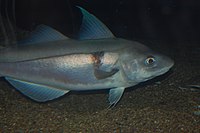Melanogrammus aeglefinus
| Haddock | |
|---|---|
 |
|
| Melanogrammus aeglefinus | |
 |
|
| Haddock at the New England Aquarium | |
| Scientific classification | |
| Kingdom: | Animalia |
| Phylum: | Chordata |
| Class: | Actinopterygii |
| Order: | Gadiformes |
| Family: | Gadidae |
| Genus: |
Melanogrammus T. N. Gill, 1862 |
| Species: | M. aeglefinus |
| Binomial name | |
|
Melanogrammus aeglefinus (Linnaeus, 1758) |
|
| Nutritional value per 100 g (3.5 oz) | |
|---|---|
| Energy | 469 kJ (112 kcal) |
|
0.0 g
|
|
| Dietary fiber | 0.0 g |
|
0.93 g
|
|
|
24.24 g
|
|
| Vitamins | |
| Thiamine (B1) |
(3%)
0.040 mg |
| Riboflavin (B2) |
(4%)
0.045 mg |
| Niacin (B3) |
(31%)
4.632 mg |
| Pantothenic acid (B5) |
(3%)
0.150 mg |
| Vitamin B6 |
(27%)
0.346 mg |
| Folate (B9) |
(3%)
13 μg |
| Vitamin C |
(0%)
0.00 mg |
| Minerals | |
| Calcium |
(4%)
42 mg |
| Iron |
(10%)
1.35 mg |
| Magnesium |
(14%)
50 mg |
| Phosphorus |
(34%)
241 mg |
| Potassium |
(8%)
399 mg |
| Zinc |
(5%)
0.48 mg |
|
|
| Percentages are roughly approximated using US recommendations for adults. Source: USDA Nutrient Database |
|
The haddock (Melanogrammus aeglefinus) is a saltwater fish, found in the North Atlantic Ocean and associated seas.
The haddock is easily recognized by a black lateral line running along its white side (not to be confused with pollock which has the reverse, i.e., white line on black side) and a distinctive dark blotch above the pectoral fin, often described as a "thumbprint" or even the "Devil's thumbprint" or "St. Peter's mark".
Haddock is most commonly found at depths of 40 to 133 m (131 to 436 ft), but has a range as deep as 300 m (980 ft). It thrives in temperatures of 2 to 10 °C (36 to 50 °F). Juveniles prefer shallower waters and larger adults deeper water. Generally, adult haddock do not engage in long migratory behaviour as do the younger fish, but seasonal movements have been known to occur across all ages. Haddock feed primarily on small invertebrates, although larger members of the species may occasionally consume fish.
Haddock range in size between 38 and 69 centimeters in length and 0.9 to 1.8 kilograms in weight. Growth rates of haddock have changed significantly over the past 30 to 40 years. Presently, growth is more rapid, with haddock reaching their adult size much earlier than previously noted. However, the degree to which these younger fish contribute to reproductive success of the population is unknown. Growth rates of haddock, however, had slowed in recent years. Some evidence indicates it may be the result of an exceptionally large year class in 2003. OneSpawning occurs between January and June, peaking during late March and early April. The most important spawning grounds are in the waters off middle Norway, near southwest Iceland, and Georges Bank. An average-sized female produces approximately 850,000 eggs, and larger females are capable of producing up to 3 million eggs each year.
Cod and related species are plagued by parasites. For example, the cod worm, Lernaeocera branchialis, starts life as a copepod, a small, free-swimming crustacean larva. The first host used by cod worm is a flatfish or lumpsucker, which they capture with grasping hooks at the front of their bodies. They penetrate the lumpsucker with a thin which they use to suck its blood. The nourished cod worms then mate on the lumpsucker.
...
Wikipedia

